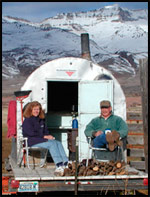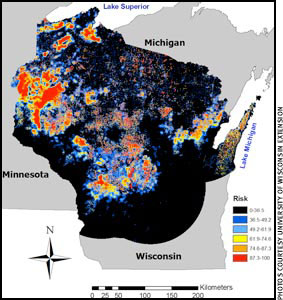MANAGEMENT...
Mapping the Risk
Livestock risk from Wisconsin wolves localized, predictable, says Wisconsin researcher.
It's an issue that crops up wherever humans and big predators — wolves, bears, lions — coexist.
"It's just hard to live alongside large carnivores. They damage crops, they kill livestock and pets, they threaten people's safety," says University of Wisconsin-Madison (UW-Madison) environmental studies professor Adrian Treves. And the sheer presence of a wolf nearby has typically been enough to make farmers fear for their animals, he adds. "Wherever there were carnivores, people thought there was risk."
But, not all wolves are big and bad. Even as Wisconsin's wolf population grows, intensifying the potential for conflicts with people, Treves' research is revealing that one of the most visible types of conflict — attacks on livestock — is highly localized and may be predictable. Read more.

Ron Torell with his wife, Jackie
Cow Camp Chatter
Hardware disease.
As a kid I remember my dad announcing that the milk cow was showing signs of haywire disease. My brothers and I laughed; we thought the cow was actually going crazy!
Actually, my dad was referring to hardware disease.
His generation called it haywire disease primarily due to the extensive use of hay wire during that time period. The high occurrence of hardware disease was due to cattle ingesting small pieces of wire, which would then lodge in the reticulum, causing problems and often death. My dad lectured us to pick up wire after feeding as a preventative measure.
When baling twine replaced baling wire, this resulted in a reduced incidence of hardware disease for the next 30 years or so. It seems, however, that this malady is yet again on the rise. In this edition of "Cow Camp Chatter" we'll discuss why this may be, as well as what symptoms to look for and some measures to help in prevention. Read more.
First-born Beef Advantage
Early-born calves have a better chance than later-born calves of making a profit for their owners. That's what a 2010 study of Iowa Tri-County Steer Carcass Futurity (TCSCF) data helped confirm. The analysis looked at birth date and age of Angus-Simmental rotational crossbred calves, compared to their feedlot performance and carcass traits.
Birth-to-harvest data on 1,369 spring-born calves from 2002 to 2007 on a central Missouri ranch were divided into four groups by date of birth.
Those born in the first 21 days qualified for the Certified Angus Beef® (CAB®) brand 28.6% of the time, compared to only 11.24% for the calves born after Day 63. Calves born Day 22 through Day 42 graded 24.37% CAB, while those born Day 43 to Day 63 managed only 16.28% qualifiers. Read more.

Kris Ringwall
Beef Talk
Increasing input costs are troublesome.
Numbers are sketchy, but perhaps that remains at the heart of many issues in the beef business. Granted, there are numbers by the truckload for markets and feedlots. These numbers are utilized daily and help guide those involved in some portions of the beef industry.
However, when one visits with cow-calf producers, the numbers become more distant and more extrapolated from assorted best guesses. The questions often put forward are why cow-calf producers are not expanding their production or why new producers are not stepping up to the plate to take over operations. Read more.
New Products
Industry affiliates provide a wide array of products and services to assist you on the farm and ranch. Here's an assortment of new products to hit the market recently.
- Single-injection treatment approved
- More-convenient packaging for turf herbicide
- Stock trailers with longer base length
- Spotlight with tighter spot beam
- Virtual welder training software upgrade
Include Animals In Disaster Preparedness Plan
If your part of the world is at risk for a tornado, blizzard or hurricane, you should have a severe weather response plan that covers your animals as well as your family.
Suzett Hexum, an adjunct professor at the University of Illinois College of Veterinary Medicine and a veterinarian with the U.S. Department of Agriculture (USDA) Animal and Plant Health Inspection Service (APHIS), offers animal owners these tips for natural disaster readiness. Read more.
Flood Refugees Can Be Dangerous
Wild animals fleeing floods cause people problems.
Flooding from the Mississippi and other rivers is disrupting even the wildlife as it brings activities to nearly a standstill in many areas.
The river flooding is displacing wildlife, moving them to higher and drier areas, where they sometimes cause problems as they interact with humans. Deer, raccoons, opossums, snakes and ants are all often found in unexpected places during times of flooding.
Bronson Strickland, wildlife management specialist with the Mississippi State University Extension Service, said animals fleeing from trouble go to the first place that seems suitable. Read more.
Tips for Returning to Homes After Flooding
Area residents returning to homes damaged by flooding can protect themselves by following some simple safety precautions, a South Dakota State University (SDSU) professor said.
Professor Kim Cassel in SDSU's College of Education and Human Sciences said the Extension Disaster Education Network, or EDEN, has assembled flood preparation, response, recovery and mitigation resources from a national network of experts. Read more.
Angus Advisor
Click here for June herd management tips from cattle experts across the nation. Advice separated by region.
[Click here to go to the top of the page.]











